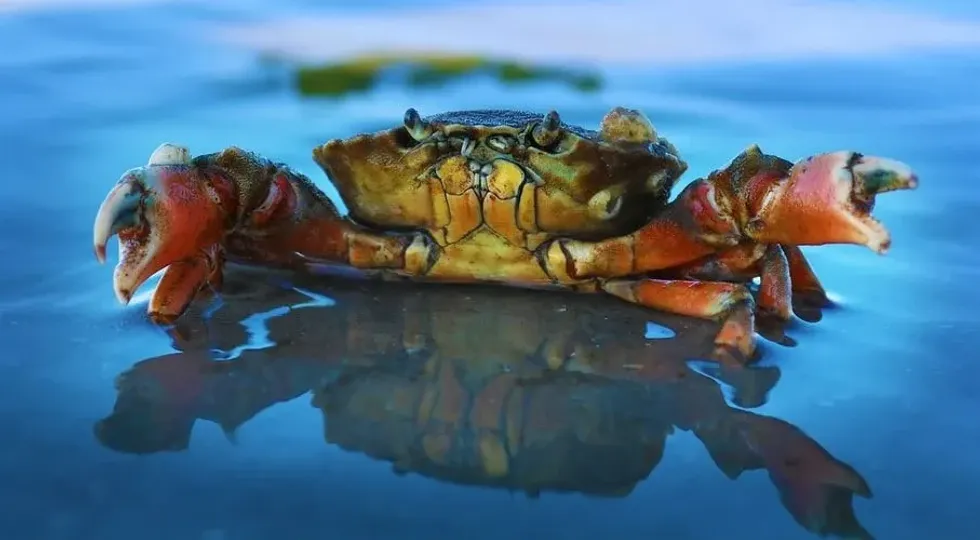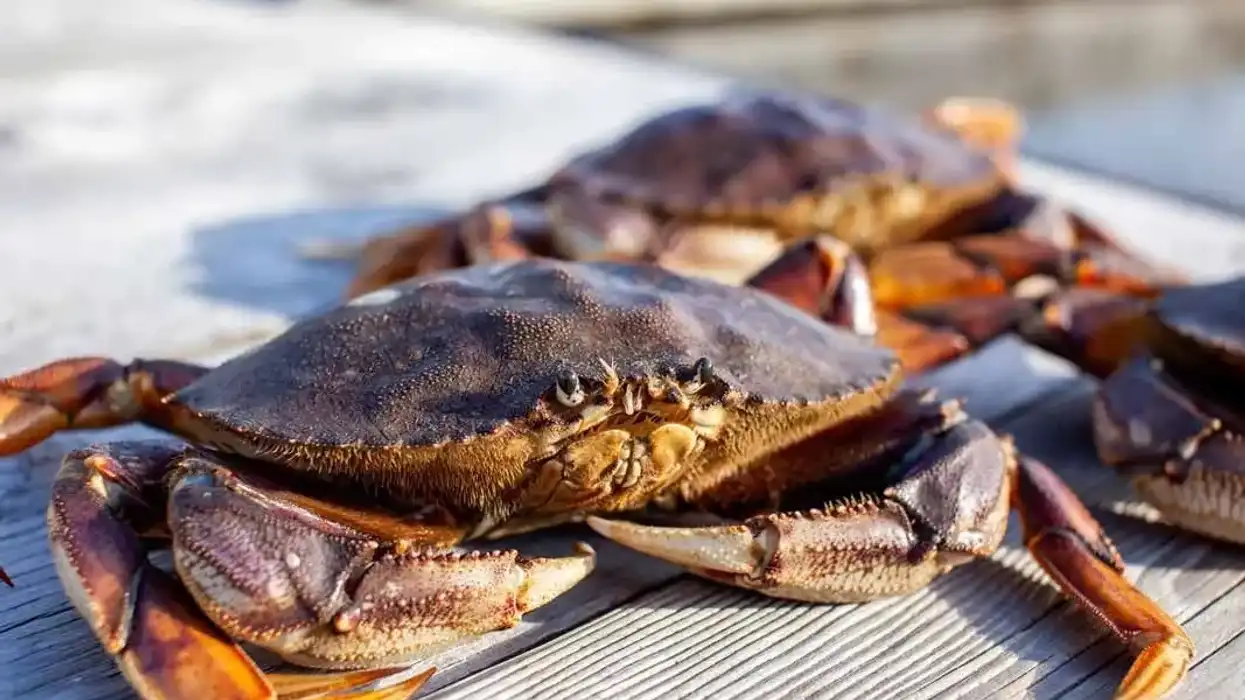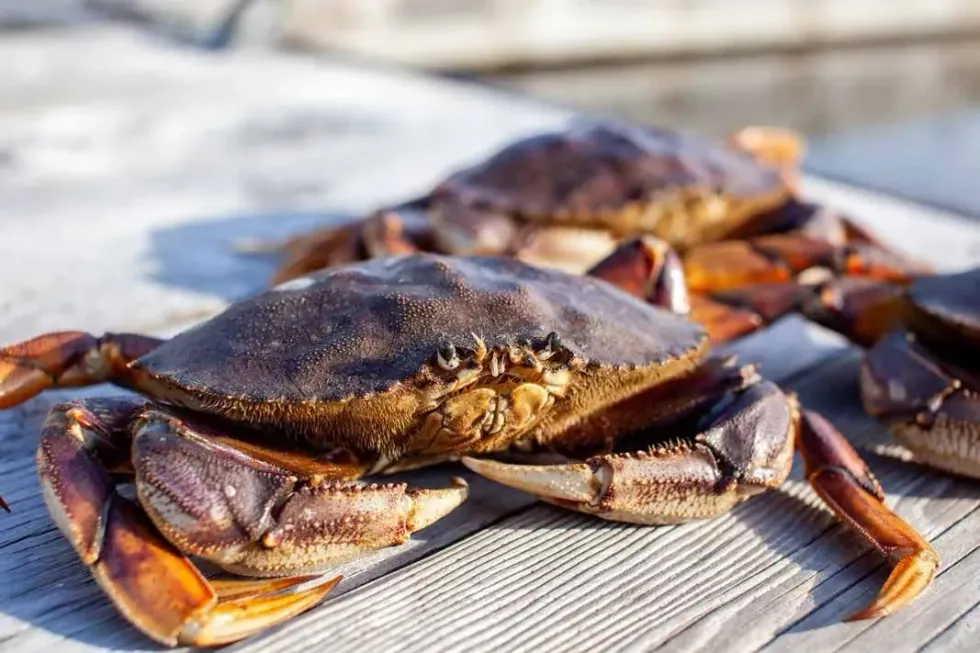Fun Dungeness Crab Facts For Kids

Dungeness crabs are large crustaceans that live in sandy or muddy bottoms of oceans. A Dungeness crab can be alive in water as well as on land.
They prefer to live in salty seawater and sometimes come up on the beach to rest under the sun. A Dungeness crab has an outer shell or exoskeleton called a carapace that protects its body from predators.
Its body is divided into three parts, the head, the thorax, and the abdomen. The Dungeness crab is a decapod.
The four pairs of walking legs including the pair of claws are attached to the thorax. With the increasing, a Dungeness crab sheds its shell and forms a new one around it in a process known as molting. This process of forming new shells can take few months.
Their compound eyes are made of tiny units and give them better vision. Genetic diversity is noticed among these animals due to such a vast extending range of their habitats and each of them has different oceanographic and physical conditions.
Their population varies a lot due to different rates of reproduction every year. Find out more about this diverse animal by going through these informational Dungeness crab facts.
For similar content check out the articles on yellow jacket wasps and cicada killer wasps.
Dungeness Crab Interesting Facts
What type of animal is a Dungeness Crab?
The Dungeness crab, Cancer magister (the conventional name recognized by ITIS), or Metacarcinus magister (the conventional name recognized by WoRMS) is a type of ocean water edible crab and the crab meat is heritage seafood of North America.
What class of animal does a Dungeness Crab belong to?
Dungeness crabs belong to the class Malacostraca.
How many Dungeness Crabs are there in the world?
The Fisheries Department of northwest American coasts, where Dungeness crabs are found in abundance, seem to be positive regarding the population of these crabs. It was seen that the average crab population has increased five times that of the past decades in the western coasts including Central California.
In the past decades, crabs have faced extreme overhunting. Fishermen of the entire coast stretching from California to Washington caught many Dungeness crabs at that time.
Despite that, crab's population either continued to increase or remained stable as estimated by the West Coast Dungeness Stock in its first thorough estimation.
Intensive harvesting is one of the causes of this population rise. The exact number of Dungeness crabs that are present all over the world is unavailable due to its hard estimation processes.
Where does a Dungeness Crab live?
The name Dungeness crab comes from the port of Dungeness located in Washington. The range of inhabitable areas of this species in North America extends from the Aleutian Islands of Alaska to Point Conception that is located near Santa Barbara in California.
Sometimes their traces can be seen even in the southern parts like the Magdalena Bay of Mexico. Analysis of the genetics of Dungeness crabs shows that one species of these crabs live across the system of California Current of the Pacific Coast.
What is a Dungeness Crab's habitat?
A Dungeness crab gets its name from one of its most fertile habitats known as the Dungeness Spit of Northwestern Washington. It is a sandy stretch of land which is located on the Strait of Juan de Luca.
They live in huge numbers in North America inhabiting the water beds and the eelgrass beds of the western Pacific coast. Alaska has a very diversified habitat.
Its vast water resources are home to a large number of fish and wildlife. In Alaska, Dungeness crab's ideal habitat includes tundra wetlands and healthy watersheds.
The younger crabs prefer estuarine areas at a shallow depth and try to avoid overlapping their habitat with the adults. Adult crabs can live at different levels of depth of the ocean but are most abundant over 90m in depth.
Who do Dungeness Crabs live with?
Some crabs prefer to live alone though some live in groups. The collective name for a group of crabs is cast.
Male Dungeness crabs after maturing can be found to be a part of large groups called aggregates. These aggregates are found in trenches of 36 in - 196 in (1 m-5 m) depth and provide safety from their usual predators. The groups sometimes might appear as selfish herds.
Many female groups are present in the Alaskan sea where they refrain from reproducing annually. These are mainly large-size female Dungeness crabs who molt often.
How long does a Dungeness Crab live?
Dungeness crabs do not have a long lifespan, that is they are short-lived species that can live for an average of 10 years, given they are not hunted. The maximum estimated lifespan of these crabs is between eight and 13 years.
However, due to such high demand for crab meat, they fall prey to the department of fish to provide these as delicacy items.
How do they reproduce?
Crabs have a hard shell on the outside that does not grow along with their body. With aging, crabs shed their shell and this process is known as molting.
Young crabs take two years, or ten molts, to mature fully and pass through five larval stages. Female crabs, on gaining maturity, start to molt and their molting season lasts from May to August.
Mating between the males and females occurs just after their molting month's end and right before their exoskeleton becomes hard. Females release pheromones through their urine which attracts the males to their potential mates.
On meeting their mate, the male crab initiates a premating embrace for the female that lasts quite a long time. This is done mainly to make the female crab feel safe with its mate.
Breeding occurs only when the female molts and shows its readiness to mate with the male. After several months, a female extrudes its eggs from its body but the eggs remain attached to its abdomen until they hatch after three or four months.
What is their conservation status?
The conservation status of Dungeness crab is not enlisted under the IUCN Red List. However, this species is not extinct.
There are abundant crabs found in the salty sea of North America and their populations have been increasing since the past decades or have been stable in different parts of their habitable areas. Adapting effective rules have helped to make the conservation of Dungeness crab stable. Their rising pattern of the population looks quite promising to the fisheries department.
Dungeness Crab Fun Facts
What do Dungeness Crabs look like?

A Dungeness crab has a wide and hard shell on top. They molt this shell to form a new one. They have four pairs of legs and one pair in the front that has its claws.
These clawed legs are known as chelipeds and help the crab to tear its food. The legs are attached to the thorax.
On the head, the crab has two stalks and the eye sockets are located on the stalk. At the rear end of a Dungeness crab thorax, a small abdomen is present. They appear to be purplish-brown in color.
How cute are they?
A Dungeness crab looks like a normal crab. The shell covers most of its body and there is no face as such. However, these saltwater animals are good companions as well as a food delicacy for many people.
How do they communicate?
A crab is assumed to communicate by a process called stridulation. A crab rubs its claws against the legs and communicates by the sound it makes. However, this is a general process. The communication procedure of all types of crab is still unknown.
How big is a Dungeness Crab?
The width of the carapace or the outer portion of the shell or exoskeleton of a typical Dungeness crab varies in size from 7-9 in (18 cm-23 cm). The mature species residing in areas of Washington may reach 10 in (25 cm). The length of the body of an adult Dungeness crab is between 4-5 in (10 cm-13 cm).
How fast can Dungeness Crabs move?
A Dungeness crab is a big crab that has eight legs and two claws and these eight legs help them to walk. They walk sideways by pushing their forelegs first and then pull the other ones to the side.
A crab does not move fast if not necessary. When a crab feels approaching danger it can be seen dragging its legs faster.
How much does a Dungeness Crab weigh?
When it reaches maturity, a Dungeness crab's weight varies typically between 2 lb - 3 lb (1 kg - 2 kg). The weight of a mature Dungeness crab will not exceed 4 lb at the most.
What are their male and female names of the species?
Male species of crab are commonly called bucks and the female crabs are called Jenny. As Dungeness crabs fall under species of crab the male and females will also be known by this name.
What would you call a baby Dungeness Crab?
The larva or the baby crab in its first stage right after the egg hatches is called Zoea larva. Zoey larva is protected by the spine present behind its head which prevents the predators from preying on it. It is transparent.
What do they eat?
Dungeness crab eats along the sea bed. They are scavengers in nature but can turn into carnivores if they get the right opportunity. It is a forager crab.
Dungeness crab food includes small fishes, shrimps, worms, small crabs, and mussels. Their favorite food is clams. Sometimes they also feed on the dead body of water organisms so they are taken to be scavengers.
Dungeness crabs form the food of some other large fish or other species of crab. Dungeness crab fresh larva is a favorite food of salmon and some other fish. The preserved fresh and frozen crab is served to humans as seafood.
Are they harmful?
Dungeness crabs can be poisonous and eating them can result fatally. The health department of California, where Dungeness crab is found in the largest number, has declared this crab to be toxic. High levels of domoic acid have been found in their body, accumulated in crab meat.
This poisonous toxin affects human beings when they eat fresh crab meat. Shellfish poisoning can turn out to be very harmful to people. When they are alive they are scared to come near human habitations.
Would they make a good pet?
A Dungeness crab can actually make a good companion as a pet. Usually, hermit crabs are the ones who are mostly kept as pets but saltwater crabs can also be nice pets.
For petting this crab the main requirement is a large tank filled with salty water and maintaining the right temperature in those tanks is also a key requirement.
Did you know...
A Dungeness crab can yield more meat than any other crab because it is heavier than many crabs and 25% of its weight is formed by its meat.
How many eyes do Dungeness crabs have?
A Dungeness crab has a pair of compound eyes sitting on the stalks located on the top of the head. They help the crab to see what's in front of them and protect themselves from danger. Eyes are protected in the eye sockets.
How do they find their new shell?
As we change our clothes, the Dungeness crab finds its new shell by the process of molting. They shed their shell with maturity, and as their bodies grow larger.
Their shell does not grow with the rest of their body. A Dungeness crab absorbs some amount of calcium carbonate from its old shell and releases certain enzymes that help in the detachment of the old shell from the skin.
After shedding their old shell off, they secrete a very soft and paper-like skin which gradually hardens into a new shell. This process in a Dungeness crab can take several weeks.
Here at Kidadl, we have carefully created lots of interesting family-friendly animal facts for everyone to discover! Learn more about some other arthropods including the orb-weaver spider and the house centipede.
You can even occupy yourself at home by drawing one of our Dungeness crab coloring pages.
We Want Your Photos!
More for You
Bachelor of Arts specializing in Journalism and Mass Communication, Postgraduate Diploma in Sports Management

Moumita DuttaBachelor of Arts specializing in Journalism and Mass Communication, Postgraduate Diploma in Sports Management
A content writer and editor with a passion for sports, Moumita has honed her skills in producing compelling match reports and stories about sporting heroes. She holds a degree in Journalism and Mass Communication from the Indian Institute of Social Welfare and Business Management, Calcutta University, alongside a postgraduate diploma in Sports Management.
Bachelor of Law

Abdulqudus MojeedBachelor of Law
A versatile professional with a passion for creative writing and technology. Abdulqudus is currently pursuing his Bachelor of Law from the University of Lagos and has experience as a tutor, intern assistant, and volunteer. He possesses strong organizational skills and is a detail-oriented person.
Disclaimer
1) Kidadl is independent and to make our service free to you the reader we are supported by advertising. We hope you love our recommendations for products and services! What we suggest is selected independently by the Kidadl team. If you purchase using the Buy Now button we may earn a small commission. This does not influence our choices. Prices are correct and items are available at the time the article was published but we cannot guarantee that on the time of reading. Please note that Kidadl is a participant in the Amazon Services LLC Associates Program, an affiliate advertising program designed to provide a means for sites to earn advertising fees by advertising and linking to Amazon. We also link to other websites, but are not responsible for their content.
2) At Kidadl, we strive to recommend the very best activities and events. We will always aim to give you accurate information at the date of publication - however, information does change, so it’s important you do your own research, double-check and make the decision that is right for your family. We recognise that not all activities and ideas are appropriate for all children and families or in all circumstances. Our recommended activities are based on age but these are a guide. We recommend that these ideas are used as inspiration, that ideas are undertaken with appropriate adult supervision, and that each adult uses their own discretion and knowledge of their children to consider the safety and suitability. Kidadl cannot accept liability for the execution of these ideas, and parental supervision is advised at all times, as safety is paramount. Anyone using the information provided by Kidadl does so at their own risk and we can not accept liability if things go wrong.
3) Because we are an educational resource, we have quotes and facts about a range of historical and modern figures. We do not endorse the actions of or rhetoric of all the people included in these collections, but we think they are important for growing minds to learn about under the guidance of parents or guardians.







